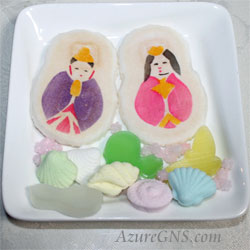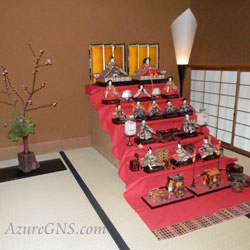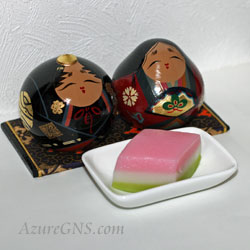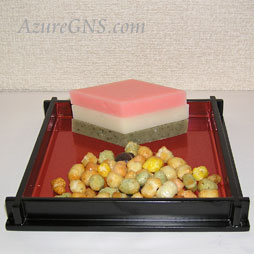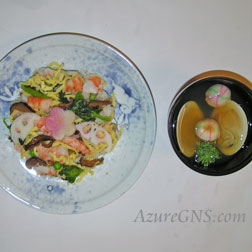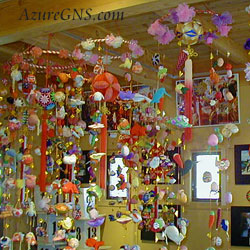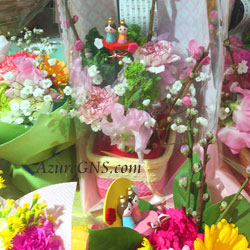(3月3日)
Hina-matsuri;
The Doll Festival
(March 3rd)
●雛祭り Hina-matsuri; the Doll Festival; the Girls’ Festival
●雛人形 Hina-ningyo; Hina dolls
●内裏雛 (a pair of) Dairi-bina; the Emperor and the Empress
●三人官女 Sannin-kanjo; (a set of) three ladies-in-waiting of the court
●五人囃子 Gonin-bayashi; (a set of) five court musicians
●随身(ずいじん) Zuijin; two retainers
●左大臣 Sa-daijin; the Minister of the Left
●右大臣 U-daijin; the Minister of the Right
●衛士(えいし;えじ) Eishi; Eji; a set of three court guards; a set of three court officials
●雛壇 Hina-dan; special doll stand;
a tiered stand for displaying Hina dolls
●金屏風 a kin-byobu; a gilded folding screen
●雪洞(ぼんぼり) bombori; a pair of lamps with paper shades;
a pair of paper-covered standing lamps
●左近のさくら Sakon-no-sakura; a cherry tree on the left
●右近の橘 Ukon-no-tachibana; a mandarin orange tree on the right【米Am.】
a satsuma orange tree on the right【英Br.】
●緋毛氈(ひもうせん) himosen; a scarlet felt covering
●菱餅 hishi-mochi; diamond-shaped rice cakes; lozenge rice cakes
●白酒 shiro-zake; white sake containing rice malt
●雛あられ hina-arare; sweetened puffed rice; sweet rice cracker
◆雛祭りは3月3日に行われる女の子の成長と健康を祝う伝統的なお祭りで、この時期に咲く桃の花にちなみ「桃の節句」とも呼ばれます。
Hina-matsuri, the Doll Festival, is a traditional festival to celebrate a girls’ growth and good health on March 3rd, and this festival is also known as “Momo-no-sekku (the Peach Festival)” because peach flowers are blooming around this time.
◆明治時代(1868-1912)の初めまで、旧暦の3月3日(新暦では4月の初旬)に雛祭りは行われたので、その名残で現代も旧暦の3月3日や4月3日に祝う地方があります。
Until the beginning of the Meiji period (1868-1912), Hina-matsuri was annually held on March 3rd by Japan’s old lunisolar calendar (around the beginning of April by the Gregorian calendar); therefore, in some districts, Hina-matsuri is still held on March 3rd by the old calendar or April 3rd.
◆雛祭りの起源は諸説ありますが、平安時代(794-1185)の京都で貴族によって祝われたという記録が残っています。
There are different theories about how Hina-matsuri started, but it is recorded that Hina-matsuri was already celebrated by the aristocracy in Kyoto in the Heian period (794-1185).
◆人々は人形を作り、自分の名前をそれに書き、川に流すと厄払いができると信じていました。
People believed that they could drive away evil spirits if they made dolls, wrote their names on them and floated them down the river.
◆人形を川に流す、流し雛の風習がまだ残っている地方もあります。
Nagashi-bina, the custom of floating dolls down the river, still remains in some regions.
◆現代では、小さな娘のいる家庭の多くは、雛人形を雛段に飾って祝います。
These days, many families with little daughters celebrate by displaying Hina-ningyo (Hina dolls) on Hina-dan (a special doll stand).
◆雛段は5段、または7段で、鮮やかな赤い布で覆われています。
Hina-dan is built with 5 or 7 shelves and covered with a felt scarlet cloth.
◆人形は平安時代の美しい宮廷衣装を着ています。
Dolls are dressed in beautiful court costumes of the Heian period.
◆内裏雛は最上段の金屏風の前に飾ります。
A pair of Dairi-bina, the Emperor and the Empress, are displayed in front of a golden folding screen on the top shelf.
◆関東(東京を中心とする1都6県)では向かって左側に男雛、右側に女雛を飾ります。
In the Kanto area (the region including Tokyo and encompasses six prefectures), people display Otoko-bina (the Emperor), on the left, and Onna-bina (the Empress), on the right from the viewer’s perspective.
◆京都では御所の玉座の位置に基づき、伝統的に関東風の逆、向かって右側に男雛、左側に女雛を飾ります。
In Kyoto, people traditionally display them in reverse order of the Kanto style; Otoko-bina on the right, and Onna-bina on the left from the viewer’s perspective in accordance with the order of the sitting places for the Emperor and Empress in the Imperial Court.
◆2段目に三人官女、3段目に五人囃子、4段目に2人の随身、5段目に3人の仕丁、または衛士を飾ります。
Three ladies-in-waiting are on the second shelf, 5 musicians are on the third shelf, 2 retainers are on the fourth shelf, and 3 court officers or guards are on the fifth shelf.
◆下段にはミニチュアの家財道具や牛車を飾ります。
Miniature household goods and an ox-drawn carriage are displayed on the lower shelves.
◆最近は限られたスペースしかない多くの家に合わせて、雛人形はより小さく、簡素化されています。
These days, Hina-ningyo have become smaller and simpler because of the limited space in many homes.
◆内裏雛だけの雛人形を持つ人が増えています。
More and more people have a set of Hina-ningyo consisting of only Dairi-bina, the Emperor and Empress.
◆雛祭りが終わったらすぐに雛人形を片付けないと、婚期が遅れるという言い伝えがあります。
There is a legend that if people don’t put Hina-ningyo away soon after Hina-matsuri is over, a girl will lose her chance to get married when she grows up.
◆地方によっては「さげもん」と呼ばれる、縁起の良い人形を吊した雛飾りを雛壇の近くに飾ります。
In some regions, “Sage-mon”, Hina-matsuri hanging decorations consisting of auspicious handmade dolls, are displayed near Hina-dan.
◆女の子が生まれると初節句までに祖母、母親、親戚のおばさんが、赤ちゃんの健やかな成長と幸福を願う気持ちを一針、一針に込めて縫います。
Newborn girls’ grandmothers, mothers and aunties sew dolls for “Sage-mon” stitch by stitch, praying for the girls’ healthy growth and happiness until their first Hina-matsuri.
◆白酒を飲み、菱餅や雛あられを食べて楽しく過ごします。
People enjoy drinking shiro-zake (white sake containing rice malt), eating hishi-mochi (diamond-shaped rice cakes) and hina-arare (sweetened puffed rice or small round rice crackers).
◆菱餅は上から順番に桃色、白色、緑色の3色のものが一般的です。
Hishi-mochi commonly consists of three layers: pink, white and green, from top to bottom.
◆一説にはピンクは桃の花、白は雪、緑は草に見立てていると言われています。
It is said that pink represents a peach flower, white represents snow, and green represents grass.
◆雛あられの基本の色は菱餅同様、桃色、白色、緑色の3色ですが、現代風の雛あられには砂糖やチョコレートをコーティングしたものもあります。
The basic three colors of hina-arare are pink, white and green like hishi-mochi, and modern hina-arare can be sugar-coated or chocolate-coated.
◆雛祭りの食事の典型的なものは散らし寿司と蛤のお吸い物です。
A typical Hina-matsuri feast is chirashi-zushi (sushi rice mixed and topped with vegetables and seafood) and hamaguri-no-osumashi (clear clam soup).
◆かつて蛤のような二枚貝は女性の貞操の象徴と考えられていました。
People once regarded a bivalve, such as a clam, as a symbol of a woman’s chastity.
(より詳しい情報は「我が家の雛祭り」、「雛壇」、福岡県浮羽郡吉井町の「筑後吉井おひなさまめぐり」、福岡県柳川市の「柳川さげもんめぐり」をご覧下さい。)
(Please see “Our Doll Festival Experience“, “A Tiered Stand for Displaying Hina Dolls“, “Chikugo-Yoshii HINA Doll Tour” in Yoshii-Machi, Ukiha-Gun, Fukuoka Prefecture, and “Yanagawa Girl’s Hanging Decoration Tour” in Yanagawa City, Fukuoka Prefecture for further information.)
Copyright (C) Azure Global Network Services. All Rights Reserved.
